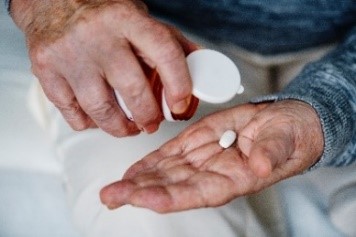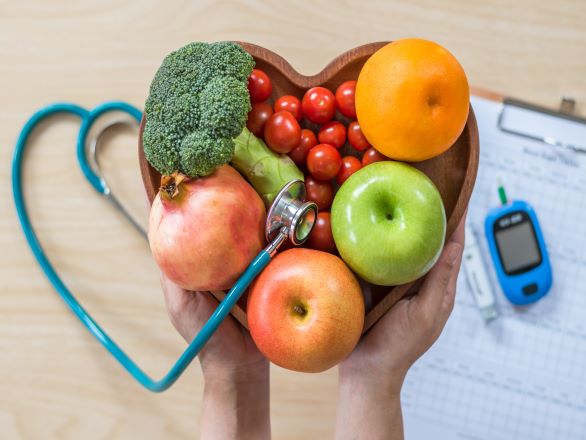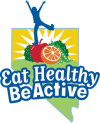In this edition
- Is Food Enough?
- Medication Therapy Management
- Advocate for Your Health Literacy
- Simply Delicious: Easy, Healthy Meals with Chef Suzy!
- Chicken with Apples and Raisins
About the Newsletter
Monthly newsletter detailing the necessity of vitamins and minerals in our diets as we age and covering: medication therapy management, advocating for you personal health literacy, and a flavorful Fall recipe sure to get you ready for Autumn.
Is Food Enough?
Leslie Baker, Pharm.D., BCGP

Older woman leaning back-to-back on older man.
Getting the necessary vitamins and minerals your body needs from food is preferred over supplements. This is because foods usually give you other nutrients too. However, sometimes it is difficult to get all the vitamins and minerals you need from the foods we eat. Older adults often do not get enough calcium, vitamins D and B12 from their diet.
Calcium is a major part of bones and plays an essential role in other functions in the body. If dietary intake of calcium is not adequate, the bones are used as a source to keep blood calcium levels normal. Many foods have calcium; dairy products contain the most, and leafy green vegetables can also be a good source according to Food Sources of Calcium - Dietary Guidelines for Americans. Men 70 years and under and women 50 years and under should consume 1000 milligrams a day. Men 71 years and older and women 51 years and older need 1200 milligrams a day. Common forms of calcium supplements are calcium carbonate (to be taken with food) and calcium citrate (can be taken with or without food). The body best absorbs about 500 milligrams of calcium at a time so you may need to take it more than once a day. The absorption of calcium supplements can be affected by medications so check with your pharmacist.
There has been a lot of information about vitamin D in the news the last few years; some scientifically proven, some not. What we do know is the body needs vitamin D for calcium absorption and low levels are a risk factor for falling. The recommendations for how much vitamin D you should take is 20 to 25 micrograms a day (800 to 1000 international unit) for men and women over 50 years old. Some foods have vitamin D added to them, but very few contain it naturally. Freshwater trout, salmon and tuna are among the highest sources, according to Food Sources of Vitamin D - Dietary Guidelines for Americans. Vitamin D is available as an individual supplement or in combination with other vitamins/minerals. Do not take more than 100 micrograms (4000 international unit) daily unless told to do so by your health care provider.
Vitamin B12 has important functions in the body, and it is not uncommon for older adults to be deficient. The body uses vitamin B12 to maintain healthy nerve cells and make red blood cells. Low levels of vitamin B12 occur because it is not absorbed well in the body, or the diet does not contain enough. Beef liver is an excellent source of vitamin B12 (Vitamin B12 - Health Professional Fact Sheet (nih.gov)). Medications, like metformin (to treat diabetes) can decrease vitamin B12 absorption. The Recommended Dietary Allowance of vitamin B12 for adults 50 and older is 100 to 400 micrograms/day. Keep in mind, multiple vitamins and other supplements contain vitamin B12.
LESLIE BAKER IS THE CERTIFIED GERIATRIC PHARMACIST AT THE SANFORD CENTER GERIATRIC SPECIALTY CLINIC. SHE IS ALSO THE PHARMACIST IN CHARGE AT THE UNIVERSITY OF NEVADA, RENO CAMPUS PHARMACY. IN ADDITION TO HER WORK AT THE SPECIALTY CLINIC, LESLIE ALSO PROVIDES MEDICATION THERAPY MANAGEMENT SERVICES THROUGH THE COMMUNITY OUTREACH PROGRAM AT THE SANFORD CENTER.
Medication Therapy Management

Hand holding a medication bottle pouring a pill into opposite hand.
Educate Before you Medicate
The Sanford Center for Aging Medication Therapy Management Program offers comprehensive medication reviews for Nevadans age 60 and older who are taking five or more prescription medications. The reviews are free for everyone, with special priority for low-income, rural and minority participants. Reviews can be done in person or over the phone with our Board-Certified Geriatric Pharmacist, and you will receive a report with recommendations.
Call 775-784-1612 or email zgibb@unr.edu today.
FOR MORE INFORMATION CALL 775-784-1612 OR EMAIL ZGIBB@UNR.EDU TODAY.
Advocate for Your Health Literacy

Woman on laptop computer.
October is Health Literacy Month. According to the Center for Disease Control, Personal health literacy is the degree to which individuals can find, understand and use information and services to inform health-related decisions and actions for themselves and others. Make sure you make smart decisions about your health by:
- Asking Questions – Don’t leave your appointment with your questions unanswered.
- Taking Notes – Write things down to help you understand and remember information.
- Bringing Someone You Trust – They can help explain things to you or recall information shared.
- Following up – Call your doctor if you’re confused.
- Asking for an Interpreter – Tell the doctor’s office what language you prefer when you make an appointment.
CLICK HERE TO READ MORE ABOUT HEALTH LITERACY.
Simply Delicious: Easy, Healthy Meals with Chef Suzy!

Heart shaped bowl with fruits and vegetables inside of it.
This live monthly cooking demonstration, sponsored by AARP, and featuring University of Nevada, Reno Extension’s very own, Chef Suzy, will air LIVE on Zoom the second Wednesday of each month starting on Oct. 13, at 11 a.m. Chef Suzy will create a meal that is sure to provide you food for thought!
CLICK HERE TO REGISTER!
Chicken with Apples and Raisins
A flavorful fall dish that can be enhanced by adding a ½ cup chopped almonds, pecans or walnuts.

A chicken dish. Photo source: Cooking Matters.
Ingredients:
- 1 large onion, peeled and diced
- 2 large carrots, peeled and diced
- 2 medium apples, diced
- 1 teaspoon ground cinnamon
- 1 teaspoon ground cumin
- 1/2 teaspoon salt, divided
- 1/4 teaspoon ground black pepper
- 5 pounds bone-in chicken pieces, breasts, thighs or drumsticks
- 2 tablespoons canola oil, divided
- 1 (15 ounces) can low-sodium chicken broth
- 3/4 cup raisins
Directions (serves 6, 1-2 pieces of chicken and ¾ cup vegetable mixture per serving):
1)In a small bowl, mix cinnamon, coriander, cumin, ¼ teaspoon salt and pepper.
2) Pat chicken with paper towels. Remove skin. Cut thighs from drumsticks (if using whole legs) and cut breast in half.
3) Rub chicken pieces with spice mixture.
4) In a large skillet over medium heat, heat 1 tablespoon oil. Add onion, carrots and apples. Cook, stirring occasionally, until starting to brown, about 15-minutes. Transfer to medium bowl.
5) Add remaining 1 tablespoon oil to skillet. Brown chicken in 2 batches. 2-4 minutes per side. Return all chicken pieces to skillet and add broth. Bring to simmer. Cook, turning occasionally, until chicken reaches internal temperature of 165°F, about 15-25 minutes depending on size of the pieces. Transfer cooked chicken to a clean plate.
6) Add raisins, vegetable mixture, and remaining ¼ teaspoon salt to skillet. Bring to a simmer and cook until liquid is almost gone, 5-10 minutes more. Serve over cooked chicken.
CHECK OUT MORE HEALTHY AND DELICIOUS RECIPES HERE.

Eat Healthy Be Active, SNAP-Ed logo.
An EEO/AA institution. This material was funded, in part, by USDA's Supplemental Nutrition Assistance Program (SNAP), an equal opportunity provider.
NEVADA SNAP-ED.


